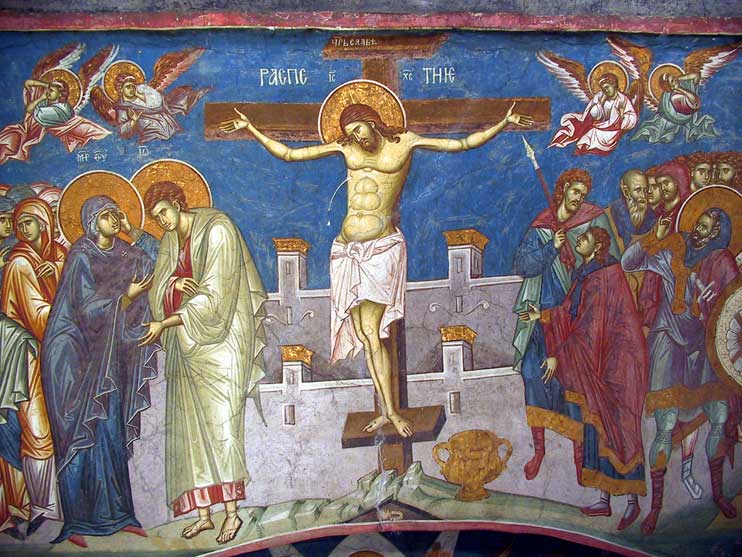
Great Lent
Having prepared the faithful for the feats of fasting and repentance, the Church introduces them to the feat itself. The services of Great Lent, as well as the services of the preparatory weeks, constantly encouraging fasting and repentance, describe the state of the soul that repents and cries for its sins. The external appearance of the Great Lenten services corresponds to this: during the ordinary days of Great Lent, with the exception of Saturday and Sunday, the full Liturgy, this most solemn and most festive service, is not served in the Church. Instead of the full Liturgy, on Wednesdays and Fridays, the Liturgy of the Presanctified Gifts is served. The composition of other church services changes in accordance with the times. On ordinary days of the week, singing almost ceases, priority is given to the reading of texts from the Old Testament, especially the Psalter, the prayer of Saint Ephraim the Syrian is offered at all church services with great prostrations (metanias), and the third, sixth and ninth hours are combined with Vespers to indicate the time until which the daily fast should last. Holy Lent and its services begin with the evening of the Holy Week. The Holy Week is also popularly called the Sunday of Forgiveness, because at the evening service of this day an act or rite of mutual forgiveness is served in the church. The act of forgiveness is performed in the following way: the icons of the Savior and the Mother of God are brought out to the altar and placed on the altar; The abbot makes prostrations in front of them and kisses them, and then usually delivers a sermon, asking the clergy and people for forgiveness of their sins, saying: "Bless me, holy fathers and brothers, and forgive me, a sinner, for what I have sinned today and in all the days of my life: in word, deed, thought and all my feelings." ("Bless me, holy fathers and brothers, and forgive me, a sinner, for what I have sinned today and in all the days of my life: in word, deed, thought and all my feelings.") At the same time, he makes prostrations in front of the clergy and people. Everyone also responds to him with prostrations, saying: "God forgive you, holy father. Forgive us, sinners, and bless us." (God forgive you, holy father. Forgive us, sinners, and bless us."). Then the abbot takes the Cross on the throne and all the clergymen according to their seniority kiss the icons on the altar, approach the abbot, kiss the venerable Cross and the hand holding the Cross, and kiss the abbot. After them, the laity approach, kiss the holy icons and the Cross, and ask each other for forgiveness.
During the rite of forgiveness, the Pokajanija otvorzi mi dveri (Repentance, open my door), Na ryekah bavilonskih (On the rivers of Babylon), and other penitential songs are usually sung. In some churches, the Easter stichera are also sung, up to the words and thus they exclaim (and thus they exclaim), including them (in the last stichera).
In accordance with the Gospel words read this week, which speak of forgiving one’s neighbors for their sins and reconciling with everyone, in ancient times Egyptian hermits gathered on the last day of the Holy Week for common prayer and, having asked each other for forgiveness and blessings, with the singing of Easter hymns, in a certain way, a reminder of the expected Easter of Christ, after the end of Vespers they dispersed into the desert for solitary asceticism during Lent and gathered again only for Palm Sunday. Therefore, even today, according to the old pious custom, the sons of the Orthodox Church, as a sign of reconciliation and forgiveness, pray for the dead and visit each other during the Holy Week. The first Sunday of Great Lent is distinguished by special severity, because it is fitting that at the beginning of the asceticism there should be zeal for a pious life. Accordingly, the Church holds longer services during the first week than on the following days. From Monday to Thursday, the penitential canon of Saint Andrew of Crete (+712) is read at Great Vespers. This canon is called the Great, both because of the multitude of thoughts and memories contained in it, and because of the number of troparions, which are about 250 (in ordinary canons there are about 30). For the purpose of reading in the first week of Lent, the canon is divided into four parts, according to the number of days. On Wednesday and Thursday, several troparions are added to the Great Canon in honor of the Venerable Mary of Egypt (+522), who rose from a deep spiritual decline to sublime piety. The Great Canon ends with troparions in honor of its creator - Saint Andrew of Crete. On Monday or Tuesday of the first week after Matins or Hours, the priest reads to the parishioners the "Prayers for the Beginning of the Lenten Fast", which are listed in the Prayer Book.
On Saturday of the first week, the Church remembers the miraculous help that the Great Martyr Theodore Tyrone (c. +306) provided to the Christians of Constantinople in the year 362, during the reign of Emperor Julian the Apostate (+363), when during the first week of Great Lent, the saint, who appeared to the Archbishop of Constantinople, commanded that kolyvo (cooked grains) be eaten instead of food desecrated by sprinkling with the blood of idol sacrifices in the marketplace. The consecration of kolyvo is performed on Friday of the first week at the Presanctified Liturgy, after the prayer from the ambo and the singing of a prayer to the Great Martyr Theodore.
In many churches, a touching liturgical rite called the Passion (from the Latin passio – suffering) is performed on Fridays or Sundays. It was introduced into church use during the reign of Metropolitan Peter Mogila of Kiev (17th century). It is served at Vespers (on Friday) or Vespers (on Sunday) of the first, second (often from the second), third and fourth weeks of Lent and consists of the reading of the Gospel of Christ’s Passion, the hymns of Holy Week – Tebe, odejuščagosja svetom, jako rizoj (You, who have clothed yourself with light, as with a garment), Priidite, ublajim Iosifa prisnopamjatnago (Come, let us call Joseph the unforgettable) and others – and a lesson. The Passions are not mentioned in the church system. The Passion Act was first mentioned at the end of the Floral Triodion, which was published in 1702 by the archimandrite of the Kiev-Pechersk Lavra, Joasaph Kronovsky. At the end of the description of the Act it is said: We remember all this by advice, and not by commandment, which is all given to the judgment of the Holy Orthodox Church.
The first Sunday (as a day of the week) of Great Lent is otherwise called the Sunday or Victory of Orthodoxy. On this day, the victory of Orthodoxy is commemorated. This is a custom that was introduced in Byzantium in the first half of the 9th century in memory of the final victory of the Orthodox Church over all heretical teachings that troubled the Church, especially over the last of them – iconoclasm, which was condemned at the Seventh Ecumenical Council in 787. On this Sunday, a special service is performed, which is called the Act of Orthodoxy. This Act was written by Methodius, Patriarch of Constantinople (842-846). The victory of Orthodoxy was first celebrated on the first Sunday of Great Lent, therefore, the basis for the celebration of this victory of Orthodoxy is historical. The Orthodox rite consists mainly of a prayer service and is served in cathedral churches after the reading of the hours before the liturgy or after the liturgy, in the middle of the temple, in front of the icons of the Savior and the Mother of God.
The second week and Sunday of Great Lent is called the Sunday of Holy Fasting: the Church prays to the Lord for the grace-filled illumination of those who fast and repent. At the services of this week and on Sunday, along with contrition for the sinful state of man, fasting is praised as a path to inner grace-filled illumination.
The Orthodox teaching on fasting is especially strongly revealed in the memory, during the second week, of Saint Gregory Palamas, Archbishop of Thessalonica (14th century). Saint Gregory was a great Athonite ascetic, known as the defender of Orthodoxy and the exposer of the heretical teaching of Barlaam, a Calabrian monk, who rejected the Orthodox teaching about the light of grace, which illuminates the inner man and is sometimes revealed visibly, for example, as was the case on Tabor and Sinai. Barlaam believed that it was impossible to achieve this illumination through prayer, fasting, and other spiritual feats of self-denial. At the Council convened for this occasion in Constantinople in 1341, Saint Gregory Palamas, who was called the son of the Divine Light, exposed the heretics and defended the teaching about the Divine Light, uncreated, ever-existing, with which the Lord shone on Tabor and with which ascetics who achieve such enlightenment through prayer and fasting are illuminated. The church service in honor of Saint Gregory Palamas and his life was written by Philotheus, Patriarch of Constantinople (14th century), and the canon by Gennady the Scholar (15th century).
The third Sunday of Great Lent is called the Exaltation of the Cross, because on this Sunday the Church celebrates the Holy Cross and the spiritual fruits of the Savior’s death on the Cross.
The Church has explained the significance of the Cross of Christ for those who strive in fasting in liturgical songs, in various images and allegories. Like a tree with many leaves and a dense shadow, providing shade and rest for the weary traveler, the Cross of Christ in the midst of the feat of fasting provides shade for believers and encourages them to complete their labor. The Cross of Christ, as a sign of victory over death, prepares us for the joyful celebration of the Conqueror of hell and death. The Cross of Christ is compared to the tree that sweetened the bitter waters of Mera, to the tree of life, which was planted in the midst of paradise. The good news of the Cross and the veneration of it remind us with comfort of the approaching feast of Christ's Resurrection. In addition to the celebration of the Holy Cross on which the Lord humbled himself until death, the services of the fourth week of Great Lent expose the pride of the Pharisees, which God condemned, and praise the humility of the tax collector.
Starting from Wednesday of the Exaltation of the Holy Cross, special litanies are recited at the liturgies of the Presanctified Gifts until Holy Wednesday for those preparing for enlightenment (baptism).
In the services of the fourth week, the Church offers a sublime example of the ascetic life represented by the ascetic of the 6th century, the Venerable John the Ladder, who from 17 to 80 AD, asceticized on Mount Sinai and who, in his work “The Ladder of Paradise,” described the path of man’s gradual ascent to spiritual perfection by the ladder of the soul, which raises him from earth to eternal glory. The “Ladder” lists 30 such steps, corresponding to the number of years of the Savior’s earthly life until His entry into social service to the human race.
On Thursday of the fifth week, at matins, the entire Great Canon of Saint Andrew of Crete and the Life of the Venerable Mary of Egypt (5th-6th centuries) are read, who rose from the abyss of vice through repentance to such a height of perfection and holiness that she became similar to the incorporeal angels. This service is therefore otherwise called Mary's (or less often: Andrew's) standing. In practice, it is served on Wednesday evening. The Life is divided into two parts when reading: one part is read after the kathisma, and the other after the third song of the canon. The Life of the Venerable Mary was written by Saint Sophronius, Patriarch of Jerusalem (638-644), and Saint Andrew of Crete, whom Patriarch Theodore of Jerusalem sent to the Sixth Ecumenical Council of Trullo (680-681), brought the Life of Saint Mary together with his canon. The reading of the Canon of Saint Andrew and the Life of Saint Mary of Egypt on Thursday of the fifth week at Matins was established at this Council.
On Wednesday of the fifth week at Vespers, which refers to Thursday, instead of the usual stichera on “Lord, I have called,” 24 penitential stichera of the Great Canon are sung – a work of Saint Andrew of Crete. All stichera end with: “Lord! Before I perish to the end, save me.” (“Lord! Before I perish to the end, save me.”). On Thursday, for the reading of the Great Canon, the Liturgy of the Presanctified Gifts is served and the ringing of the bells is complete, that is, not during Lent.
Saturday of the fifth week is called the Saturday of the Akathist, and the service itself is called “Praise to the Most Holy Theotokos”. On this day, the Akathist is read at Matins, which in Greek means a chant that is not to be sat down, dedicated to the Mother of God in memory of Her intercession and the deliverance of Constantinople during the days of fasting from the invasion of foreigners in the 7th century. This first Akathist was written in the 7th century on the basis of even older kondaks in which the events of the Nativity of the Lord and the Annunciation of the Most Holy Theotokos are sung.
On the fifth Sunday of Great Lent, the Church remembers and glorifies Saint Mary of Egypt. In the songs of the canons for this week, as well as in the weekly services of the following week – Palm Sunday, the Gospel story of the rich man and Lazarus is revealed in order to encourage the faithful to true repentance through which the Kingdom of God is achieved. The Church urges believers to avoid the cruelty and inhumanity of the rich and to be zealous for the patience and generosity of Lazarus, for the Kingdom of God is not food and drink, but righteousness and self-control with holiness and mercy.
On Saturday of the sixth week of Palm Sunday, the Church remembers the miracle when the Lord Jesus Christ resurrected Lazarus, which is why it is called Lazarus Saturday. By resurrecting Lazarus, Jesus Christ demonstrated His divine power and glory and assured His disciples and everyone of His upcoming resurrection and the general resurrection of the dead on the day of God's Judgment.
The flowers are dedicated to the memory of the solemn Entry of the Lord into Jerusalem, where He went to suffer and die on the Cross. This event is described by all the evangelists: Matt. 21:1-11; Mark 11:1-11; Luke 19, 29-44; Jn. 12, 12-19. This holiday is called Palm Sunday, and in the Russian colloquial language it is also called Willow Sunday, because of the custom of blessing palm branches on that day, which are replaced with willow in our country.
The holiday has its origins in ancient times. The first mention of the holiday – in the 3rd century – belongs to Saint Methodius, Bishop of Patara (+312), who left a teaching for this day. In the 4th century, the holiday, as Saint Epiphanius of Cyprus testifies, was celebrated very solemnly. Many of the holy fathers of the 4th century left their teachings for this holiday. In the 7th-9th centuries, Saints Andrew of Crete, Cosmas of Mayum, John of Damascus, Theodore and Joseph the Studite, as well as the Byzantine emperor Leo the Philosopher, Theophanes and Nicephorus Xanthopoulos, celebrated the holiday with songs that the Orthodox Church still sings today.
The Feast of the Entry of the Lord into Jerusalem is one of the twelve greatest feasts of the Lord and the Theotokos, but it has neither a pre-feast nor a post-feast, because it is surrounded by the days of Lent and Holy Week. However, although there are no pre-feast days like the other feasts of the twelve greatest, the services of the entire previous week, starting on Monday, are dedicated in many stichera and troparia to the event of the Lord's entry into Jerusalem.
On Friday of Palm Sunday, the Lenten fast ends. On this day, in one of the stichera on "Lord I have called," the following is sung: "Having completed the soul-beneficial Forty-day, we pray that we may also see the holy week of Your Passion, O Lover of Man." ("Having completed the soul-beneficial Forty-day, we pray that we may also see the holy week of Your Passion, O Lover of Man."). Lazarus Saturday and Palm Sunday serve as a transition from Lent to Holy Week.
Source: pravoslavie.ru
PHOTOS
RELATED ARTICLES
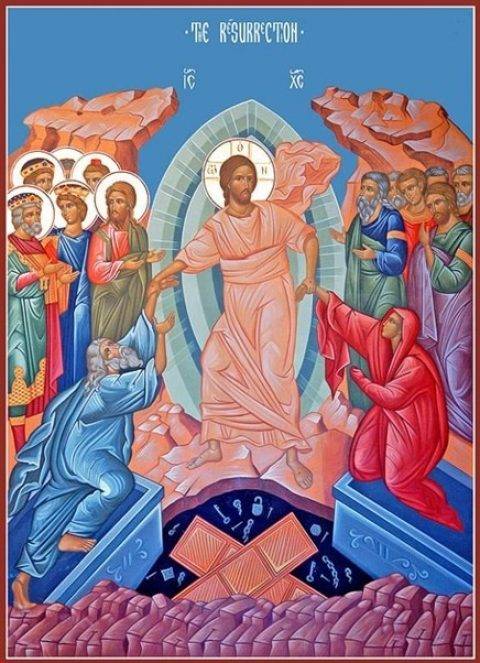
Calendar for April 20 The Resurrection of the Lord Jesus Christ – Easter
“Now after the Sabbath, as it began to dawn toward the first day of the...
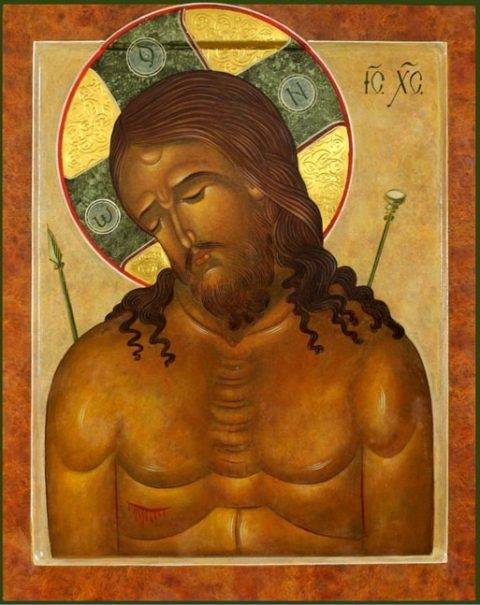
Calendar for April 19 Maundy Saturday
On the Saturday after the crucifixion, the chief priests and Pharisees came to...
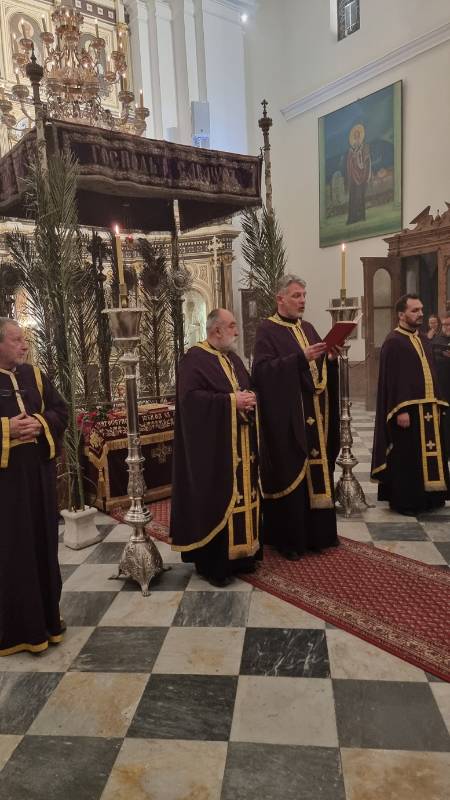
GOOD FRIDAY - SOLEMN VIGIL WITH ARTICLES SERVED TONIGHT IN THE CHURCH OF ST. NICHOLAS
In the Church of St. Nicholas, today on Good Friday, a Solemn Vigil with...


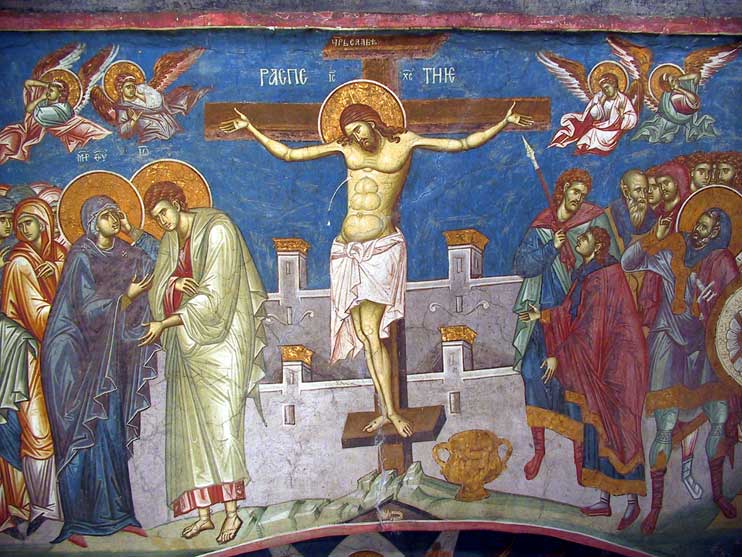

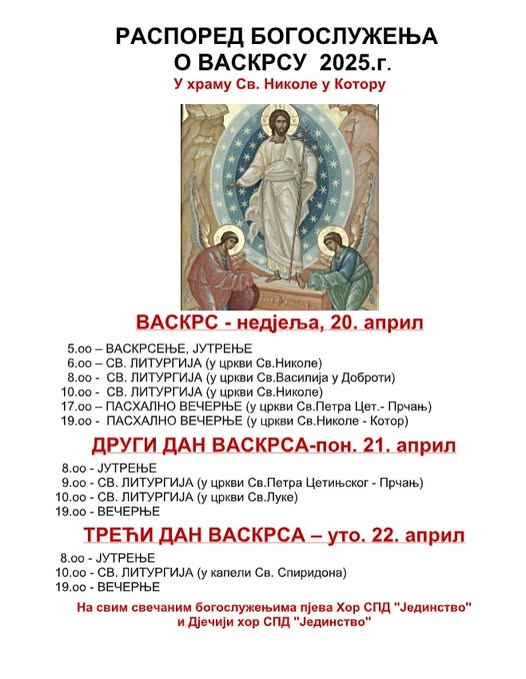
.png)